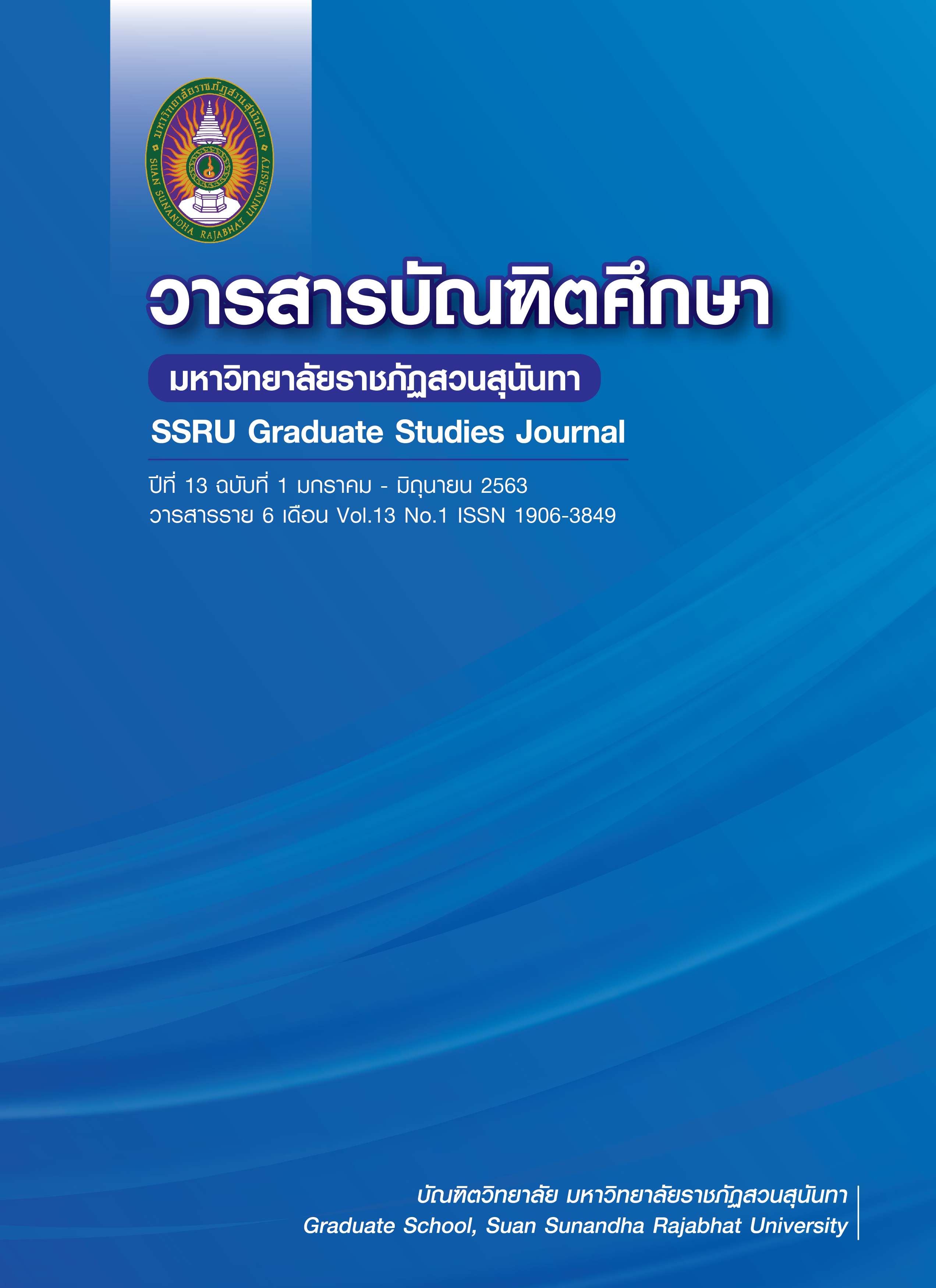Development of the Use of Information and Communication Technology (ICT) as tool for learning skill enhancement and promotion of tourist attractions in Bangkoknoi District
Main Article Content
Abstract
The objectives of this study were to: 1) examine the use of information and communication technology (ICT) as a method for learning skill enhancement for local people in Bangkok Noi community; 2) study how ICT can be used in developing digital media to promote tourism in Bangkok Noi communities, and; 3) find out a way to use ICT as a tool for learning skill enhancement for the local people in Bangkok Noi community. The sample consisted of 384 local people. The study sites were three sub-districts in Bangkok Noi area including Siriraj, Banchanglo, and Arunamarin sub-districts. Data were analysed by descriptive statistics consisting of frequency, percentage, mean, standard deviation, Kurtosis (KURT), and skewness (SKEW).
The results showed that the local people in the area could be divided in two groups based on their ICT knowledge and skills. The people in first group were able to use basis functions of a mobile phone and desired to improve their ICT knowledge and skills whereas the latter had good ICT knowledge and skills as they were able to use more functions on a mobile phone and knew how to use Internet and a computer. Both groups agreed to participate in the development of ICT skills and the use of ICT to promote tourism in the community.
Therefore, this study focused on the development of knowledge and skills of using a mobile phone through a workshop on basic ICT knowledge. The main objectives of the workshop were to provide knowledge on how to use social media on a mobile phone to promote tourism in Bangkok Noi community and to encourage the local people to be aware of the significance of ICT and how Bangkok Noi District Office and other related organizations such as Suvannaramrajworavihan Temple, Dusitaram Secondary School, Bangkoknoi Vocational Center, local museums, Trokkhaomao community and bronzework community can use a mobile phone, internet and a computer to take pictures, record videos and interviews and create different forms of social media to promote tourism in the community.
Article Details
References
ได้จาก www.tourism.go.th
ชัชพล ทรงสุนทรวงศ์. (2559) นวัตกรรมการบริการ : กลยุทธ์ที่สร้างความได้เปรียบทางการแข่งขันขององค์การธุรกิจบริการ. สาขาการจัดการ มหาวิทยาลัยศิลปากร วารสาร
การจัดการสมัยใหม่.
ดวงกมล โพธิ์นาค. (2559). การศึกษาสภาพการใช้เทคโนโลยีสารสนเทศและการสื่อสาร เพื่อสนับสนุนการเรียนรู้ของนักศึกษาระดับปริญญาตรี คณะครุศาสตร์อุตสาหกรรม
มหาวิทยาลัยเทคโนโลยีพระจอมเกล้าพระนครเหนือ. วารสารมหาวิทยาลัยราชภัฎลำปาง.
ดนุภัค เชาว์ศรีกุล, ธีรวุฒิ เอกะกุล, และกฤษมันต์ วัฒนาณรงค์. (2558). การพัฒนาความสามารถในการใช้เทคโนโลยีสารสนเทศและการสื่อสารในศตวรรษที่ 21 สำหรับ
นักเรียนระดับชั้นมัธยมศึกษาตอนต้น. อินฟอร์เมชั่น.
ไพศาล กาญจนวงศ์ และรักธิดา ศิริ. (2561). พฤติกรรมการใช้เทคโนโลยีสารสนเทศและการสื่อสารทางการท่องเที่ยวของนักท่องเที่ยวชาวจีนที่เดินทางมาเที่ยวในจังหวัด
เชียงใหม่. วารสารมหาวิทยาลัยราชภัฏยะลา.
วิทวัส ดวงภุมเมศ, และวารีรัตน์ แก้วอุไร. (2560). การจัดการเรียนรู้ในยุคไทยแลนด์ 4.0 ด้วยการเรียนรู้อย่างกระตือรือร้น. วารสารมนุษยศาสตร์และสังคมศาสตร์ บัณฑิต
วิทยาลัย มหาวิทยาลัยราชภัฏพิบูลสงคราม.
สุภัชชา ศรีชะอุ่ม, มณเทียร ชมดอกไม้, และลัดดา ศุขปรีดี. (2557). ผลการใช้ไอซีทีในการจัดการเรียนรู้ด้วยโครงการ กลุ่มสาระการเรียนรู้การงานอาชีพและเทคโนโลยี
สำหรับนักเรียนชั้นมัธยมศึกษาปีที่ 1 โรงเรียนสาธิต "พิบูลบำเพ็ญ" มหาวิทยาลัยบูรพา. วารสารการศึกษาและการพัฒนาสังคม.
สุจิตต์ วงษ์เทศ. (2560). ขุมทรัพย์ท่องเที่ยวกรุงเทพฯอยู่ในคลองบางกอกน้อย-บางกอกใหญ่. บทความศาสนา-วัฒนธรรม. บริษัท มติชน (จำกัด). สืบค้นเมื่อ 25 มกราคม
2563.เข้าถึงได้จาก www.matichon.co.th
อรรคเดช โสสองชั้น. (2563). นวัตกรรมเทคโนโลยีสารสนเทศและการสื่อสารทางการศึกษา.สืบค้นเมื่อ 27 พฤษภาคม 2563. เข้าถึงได้จาก www.sites.google.com
Partnership for 21st Century Skills. (2010). Framework definition. From documents/P21-Framework-Definitions.pdf. สืบค้นเมื่อ 27
มกราคม 2563 เข้าถึงได้จาก www.p21.org


